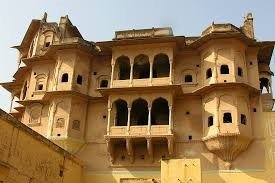
Nestled in the heart of Jhunjhunu, Rajasthan, Khetri Palace, also known as the Hawa Mahal of Jhunjhunu, stands as a testament to the region’s rich architectural heritage. Located at the western end of Nehru Bazaar, this ancient palace is renowned for its stunning design and intricate frescoes. Despite its current dilapidated condition, Khetri Palace continues to draw the attention of tourists and locals alike, serving as a major historical landmark in the town.
A Marvel of Architecture and Design
Khetri Palace, often referred to as the Wind Palace, is paradoxically devoid of conventional windows and doors. The palace was designed to ensure optimal ventilation and airflow, with large open halls and marble pillars replacing traditional walls. These architectural features, combined with the palace’s spacious corridors, create an airy and open atmosphere, making the structure feel expansive and well-ventilated.
One of the most remarkable aspects of the palace is its multi-level design, complete with ramps that were once used by horses and carts. This feature was crucial for accommodating noblemen who used horses for transportation. The palace’s highest levels offer breathtaking views of the old Muslim quarter, Pirzada Mahalla, and the wider landscape of Jhunjhunu, further enhancing its allure as a tourist attraction.
History of Khetri Palace
The palace was built in 1770 by Bhopal Singh, the grandson of Sardul Singh, who founded Khetri. Although relatively small compared to other forts, Khetri Palace quickly gained fame for its architectural brilliance. Its influence reached far beyond Jhunjhunu, inspiring Maharaja Sawai Singh of Jaipur to model his iconic Hawa Mahal after it. Built in 1799, Jaipur’s Hawa Mahal remains a symbol of India’s rich cultural heritage and shares the same “Wind Palace” nickname, paying homage to the innovative design of Khetri Palace.
Epitome of Shekhawati Art and Architecture
Khetri Palace is a prime example of the Shekhawati style of art and architecture, celebrated for its elaborate frescoes and intricately designed arches. The palace’s walls are adorned with vibrant paintings and murals, some of which are linked to other historical landmarks such as the Raghunath Temple and Bhopalgarh Fort. Although time and weather have worn down many of these artworks, the remnants still offer a glimpse into the palace’s former grandeur.
What sets Khetri Palace apart from other monuments is the absence of traditional windows and doors. Instead, it features open arches and alcoves, creating a seamless flow between different areas of the palace. The private chambers of the Thakurs, located within the palace, also include alcoves where older paintings—now mostly ruined—can still be seen.
The palace’s interconnected rooms, ramps, and arches provide a sense of proportion and sophistication to the overall structure, reflecting the architectural genius of its creators.
Visiting Khetri Palace
For those planning to visit Khetri Palace, the journey is as intriguing as the destination itself. The palace is situated within a labyrinth of narrow lanes, making it difficult to navigate by car. Visitors are advised to use public transportation or park nearby and walk to the site. The entry to the palace is through a student hostel at the base of the monument, adding an unexpected modern twist to the historical experience.
Although it may not receive as much attention as other Rajasthani palaces, Khetri Palace offers a unique window into the region’s cultural and architectural legacy. Its timeless beauty, rich history, and distinctive design continue to captivate those who visit, making it a hidden gem in the vibrant landscape of Rajasthan.

